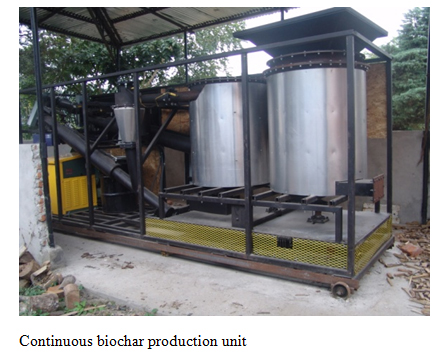Agricultural Engineering
- Developed and modified farm tools and implements for hill agriculture including 4-row pre-germinated paddy seeder, cono weeder, light weight power tiller with attachments, areca nut sheller, grass cutter attachments, seed drill for high slope conditions, pneumatic seed metering device and hand operated winnower and tested their adaptability.
- Ratio of soil and charcoal, drying characteristics, emission and burning characteristics of beehive charcoal briquettes have been determined and standardized. The economic analysis showed that a briqutte can be produced with cost of Rs.6/- and earned Rs. 2100/- month by producing 6000 briquettes
- Drainage system to drain seepage water accumulated below the agrifilm which created hydraulic pressure and ruptured the agrifilm, designed and successfully replicated in two ponds.
- Methodology for agrifilm lining of water harvesting structure standardized and successfully replicated in three water harvesting structures at different location.
- Studies on improving productivity of farming systems through rainwater harvesting in lined pond was completed. Based on the estimated annual costs and returns, internal rate of return (IRR) and benefit cost ratio (BCR) were computed as 67% and 1.526 respectively, which are found favourable for investment on plastic lined water harvesting tank integrated mixed farming systems.
- Strawberry cultivation techniques under low tunnels standardized for early planting and extended fruiting period.
- Hydrological studies of untreated agricultural hilly watershed and traditional bun system of cultivation was done obtaining the sediment yield of 46 to 87 t/ha due to traditional bun cultivation practices, 21 – 23 t/ha from agricultural hilly watershed and nutrients loss: N: 30 kg/ha, P: 28 kg/ha, K: 25 kg/ha, OC: 700 kg/ha.
- A total 1894 ha area was treated with soil conservation measures (contour bunding, bench terracing, contour hedgerow, silt retention tank/ water harvesting pond and drainage line treatments) and improved hill farming technologies. The benefit cost ratio of dairy farming, agro pastoral farming and agri-horti-silvi pastoral system was obtained as 2.08:1, 1.83:1 and 1.4:1 respectively.
- Biodegradable plastic mulch was tested and was found that it took 40 weeks for full degradation of the plastic mulch in mid hill conditions of the region with 6-11% increase in yield of broccoli and tomato.
Continuous biochar production unit
A continuous biochar production unit has been installed in the Institute to produce biochar from different agricultural and forest waste biomass. The unit is capable of converting up to 300 kg/hr of woody biomass into biochar. Shredded biomass is introduced to the partial-oxidation reactor, a controlled aerobic (O2 limited) environment that contains some limited atmospheric air, where it is carbonized at 300-550 °C for between 2-30 minutes.
The pyrolysis gas produced during the first stage is used as sweep gas for the second stage, and is primarily composed of N2, H2, CO, CH4, and other higher VOCs and trace gases. Pyrolysis gases are burned in a flare at a temperature between 500-1500°C.

Steps for making biochar by Biochar Production Unit
 |
 |
| 1. Raw materials- wood chips | 2. Collection of wood chips in 200lit drums |
 |
 |
| 3. Wood chips ready to put in biochar unit | 4. Feeding wood dips in main reactor |
 |
 |
| 5. Starting of biochar unit | 6. Initial burning inside main reactor |
 |
 |
| 7. Smoke coming out of flare | 8. Firing the exhaust gas |
 |
 |
| 9. Inspection of the running | 10. The biochar unit |
 |
 |
| 11.Inspection of biochar products | 12. Cooling of biochar by sprinkling of water |